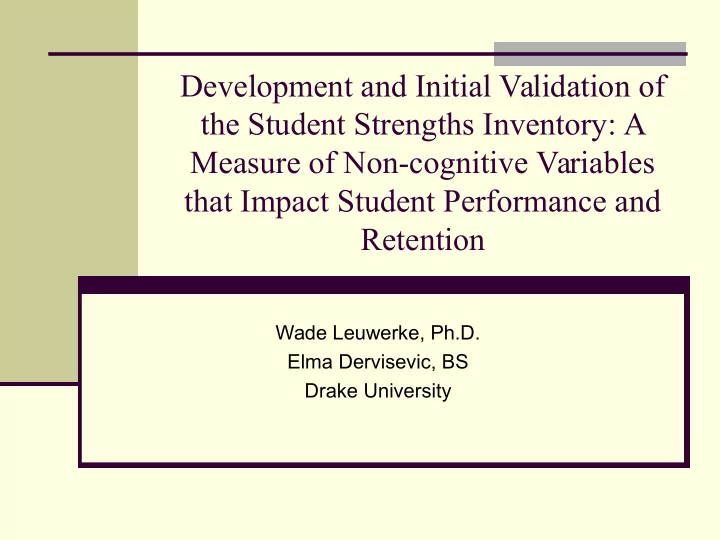

Development and Initial Validation of the Student Strengths Inventory: A Measure of Non-cognitive Variables that Impact Student Performance and Retention Wade Leuwerke, Ph.D. Elma Dervisevic, BS Drake University
Graduation and Retention Rates 34% - Four-year graduation rate at two-year institutions • (Swail, 2004) 53% - Six-year graduation rate at four-year institutions • (Carey, 2004) First to second year retention rates • (ACT, 2009) Selective 82.2% Traditional 71.5% Open 65.1% Two-Year 53.9%
Student Success Models Primary focus on cognitive factors (ACT, HSGPA) Pre-enrollment situational (e.g., SES) Post-enrollment situational (e.g., Housing) Non-cognitive/motivational (e.g., engagement) 10 non-cognitive variables that are strong predictors of student outcomes Different predictors for retention vs. performance Approximately 4 – 6 of these offer significant incremental validity over standardized tests and HS GPA Robbins et al., (2004)
SSI Development Rational and factor analytic methods Homogeneous and objective measures of six factors • Academic engagement • Social comfort • Academic self-efficacy • Resiliency • Campus engagement • Educational commitment Initial pool of 243 items developed by team of 6 researchers Reduced to 81 items through consensus 10 – 14 items for each construct 1 – 6 (strongly disagree – strongly agree)
Methods Administered to N = 760 first-year college students at two large western universities (one urban commuter and one rural residential) 45% men and 55% women Caucasian (65%), Mexican/Chicano (9%), multiracial (5%), Asian American (5%), American Indian (5%), Puerto Rican/Cuban/Other (3.4%) and African American (2.6%) Over 8,000 students included in predictive modeling analysis
Analysis Factor Analysis Principal axis factoring with oblique rotation 6 factor structure converged in 11 iterations Accounted for 45% of variance among items Reliability Internal Consistency Construct Validity Correlation with Student Readiness Inventory Predictive Validity Prediction of retention and first semester GPA
Factor Correlations Factor 1 2 3 4 5 6 1 Educational Commitment 1 2 Social Comfort .150 1 3 Resiliency .052 .217 1 4 Campus Engagement .329 .302 .114 1 5 Academic Engagement .320 .090 .142 .178 1 6 Academic Self-Efficacy .376 .186 .177 .316 .336 1
Reliability and Construct Validity Cronbach’s alphas ranged from .81 to .90 Cross measure correlations SRI CC SA EC SC AD ASC 1 Educational Commitment .58 .11 .09 .23 .38 .10 2 Social Comfort .22 .67 .18 .51 .08 .10 3 Resiliency .04 .14 .50 .05 .03 .27 SSI 4 Campus Engagement .30 .18 .13 . 39 .22 .05 5 Academic Engagement .34 .01 .18 .10 .58 .14 6 Academic Self-Efficacy .41 .13 .18 .23 .39 .37
Reliability and Construct Validity Scale relations with ACT scores and High School GPA ACT HSGPA 1 Educational Commitment .13 .13 2 Social Comfort .06 .10 3 Resiliency .02 .06 4 Campus Engagement .10 .14 5 Academic Engagement .06 .23 6 Academic Self-Efficacy .10 .28
Predictive Validity 18% ACT + HSGPA Academic Engagement First Semester 28% Academic Self-efficacy GPA Resiliency 20% ACT + HSGPA Academic Engagement First Year GPA 29% Campus Engagement Resiliency
Predictive Validity Educational First to Commitment Second Year Campus Engagement Retention
Predictive Validity Prediction of Academic Outcomes Aturitjon Percent Accurately Identjfjed Random 28.5 ACT Composite Score 28.7 ACT + HSGPA 50.9 HSGPA + SSI Risk 65.5
SW Large Rural Residential
SC Medium Rural Regional Comp
Small MNT West Rural State
Large MW Urban
Student Strengths Inventory Student Strengths Inventory Scales and Sample Items Scale Definition Sample Item Academic The value an individual places on academics and I turn my homework in on time. Engagement attentiveness to school work. Academic Self- An individual’s confidence in his or her ability to I will excel in my chosen major. Efficacy achieve academically and succeed in college. Educational An individual’s dedication to college and the value I see value in completing a Commitment placed upon a college degree. college education. Resiliency An individual’s approach to challenging situations I manage stress well. and stressful events. Social Comfort An individual’s comfort in social situations and I am comfortable in groups. ability to communicate with others. Campus Involvement in campus activities and attachment Being active in extra-curricular Engagement to the college/university. activities in college is important to me.
SSI Summary Strong reliability and validity Brief measure of non-cognitive factors Measures 6 factors critical to student success Customizable individual student report Training to support data use models and individual interpretation strategies Questions: wade.leuwerke@drake.edu www.studentstrengthsinventory.com
References ACT, Inc. (2009). National collegiate retention and persistence to degree rates . Iowa City, IA: Author. Carey, K. (2004). A matter of degrees: Improving four-year colleges and universities . Washington, DC, Education Trust. Swail, W. S. (2004). Legislation to improve graduation rates could have the opposite effect. Chronicle of Higher Education, 50. Robbins, S., Lauver, K., Le, H., Langley, R., Davis, D., & Carlstrom, A. (2004). Do psychological and study skill factors predict college outcomes? A meta-analysis. Psychological Bulletin, 130, 261-288.
Recommend
More recommend